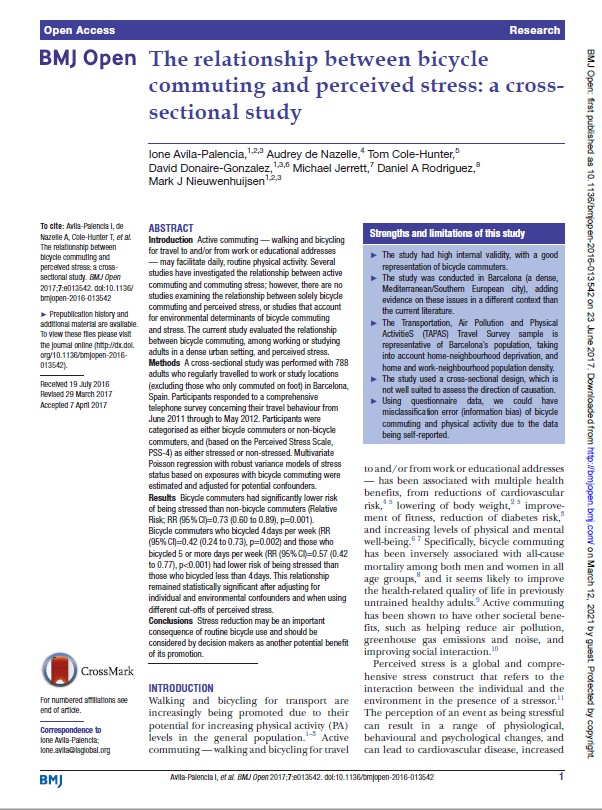The relationship between bicycle commuting and perceived stress: a crosssectional study
Tipo de publicação
Artigo
Curso ou área do conhecimento
Transporte
Veículo
BJM OPEN
Tipo de autoria
Pessoa Física
Nome do autor
Ione Avil-Palencia,1,2,3 Audrey de Nazelle,4 Tom Cole-Hunter,5 David Donaire-Gonzalez,1,3,6 Michael Jerrett,7 Daniel A Rodriguez,8 Mark J Nieuwenhuijsen1,2,
Língua
Inglês
Abrangência geográfica
Internacional/Mundial
Ano da publicação
2017
Palavra chave 1
Deslocamento
Palavra chave 2
Infraestrutura
Palavra chave 3
Políticas Públicas
Descrição
Abstract
Introduction Active commuting — walking and bicycling
for travel to and/or from work or educational addresses
— may facilitate daily, routine physical activity. Several
studies have investigated the relationship between active
commuting and commuting stress; however, there are no
studies examining the relationship between solely bicycle
commuting and perceived stress, or studies that account
for environmental determinants of bicycle commuting
and stress. The current study evaluated the relationship
between bicycle commuting, among working or studying
adults in a dense urban setting, and perceived stress.
Methods A cross-sectional study was performed with 788
adults who regularly travelled to work or study locations
(excluding those who only commuted on foot) in Barcelona,
Spain. Participants responded to a comprehensive
telephone survey concerning their travel behaviour from
June 2011 through to May 2012. Participants were
categorised as either bicycle commuters or non-bicycle
commuters, and (based on the Perceived Stress Scale,
PSS-4) as either stressed or non-stressed. Multivariate
Poisson regression with robust variance models of stress
status based on exposures with bicycle commuting were
estimated and adjusted for potential confounders.
Results Bicycle commuters had significantly lower risk
of being stressed than non-bicycle commuters (Relative
Risk; RR (95% CI)=0.73 (0.60 to 0.89), p=0.001).
Bicycle commuters who bicycled 4 days per week (RR
(95% CI)=0.42 (0.24 to 0.73), p=0.002) and those who
bicycled 5 or more days per week (RR (95% CI)=0.57 (0.42
to 0.77), p<0.001) had lower risk of being stressed than
those who bicycled less than 4 days. This relationship
remained statistically significant after adjusting for
individual and environmental confounders and when using
different cut-offs of perceived stress.
Conclusions Stress reduction may be an important
consequence of routine bicycle use and should be
considered by decision makers as another potential benefit
of its promotion.



 Ao navegar no Observatório da Bicicleta você concorda com os
Ao navegar no Observatório da Bicicleta você concorda com os